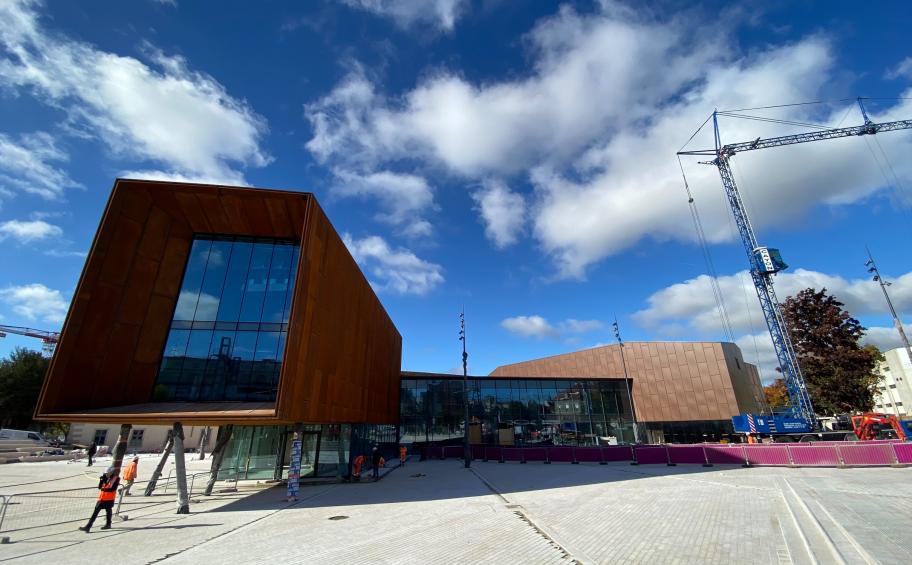In 2010, UNESCO registered the French gastronomic meal on the convention for the safeguarding of intangible cultural heritage. In June 2012, at the initiative of François REBSAMEN, Mayor of Dijon, the city council approved Dijon's application for the Cité de la gastronomie project. Following the success of its bid, the city of Dijon launched a call for expressions of interest (AMI) in 2014, which was won by the Eiffage group, which will build the Cité internationale de la gastronomie et du vin (CIGV) in Dijon. Eiffage's objective is to create a new city district; its model as a developer-constructor-developer is particularly relevant to this project. In addition to Eiffage Aménagement, Eiffage Construction and Eiffage Immobilier, it also includes the expertise of Eiffage Route, Eiffage Energie Systèmes and Chastagner (now known as Demcy).
The emblematic and large-scale project was designed by Agence d'Architecture Anthony Béchu / Perrot&Richard and includes several areas:
- THE CULTURE AND EXHIBITIONS AREA: 1,750 sqm of exhibitions in the Gastronomy and Wine Pavilion and the Grande Chapelle provide the keys to understanding the French gastronomic meal and the importance of wine in this cultural heritage
- TRAINING: The Ferrandi Paris School will offer training in French pastry and cuisine, and will be located in the emblematic Canon de lumière. The Wine School of the Bureau Interprofessionnel des Vins de Bourgogne (BIVB) will have a 70 sqm space dedicated to oenological initiation to enable Dijon residents and tourists to familiarise themselves with wine tasting.
- THE VILLAGE BY CA: Together with Vitagora (the competitiveness cluster focusing on "taste, nutrition and health") and Food Tech (a support network for start-ups working on food and nutrition), the Village by CA, which will be located at the CIGV on a 1,500 sqm site, will bring together some fifteen start-ups.
- THE HOTEL: A 4-star luxury hotel, in the Curio by Hilton range, with 125 rooms, will be located in historic buildings dating from the 17th and 18th centuries, and in a contemporary extension. It will feature a restaurant, spa and outdoor pool. It will be BREEAM certified like the M3C.
- SHOPPING: The 5,000 sqm shopping area will include around 15 shops dedicated to gastronomy and wine, restaurants and a wine bar.
- CINEMAS: The site will house 9 cinemas, operated by the Pathé group, allowing all audiences to enjoy the 7th art.
- REHABILITATED HOUSING: The François 1er group, a specialist in property renovation operations, has rehabilitated the historic buildings around the Cours Eudes III, Jerusalem and Bégnine Bureau to accommodate around 90 homes.
- THE ECO-DISTRIBUTION: In the heart of a magnificent site, the future inhabitants will live between culture and nature. The eco-neighbourhood will include subsidised housing, two residences for sale (IntenCité and AuthentiCité) and three managed residences for students, senior citizens and tourists.
- THE ARCHITECTURE AND HERITAGE INTERPRETATION CENTRE: Intended for both residents and tourists, the 500 sqm tour will cover the major stages of Dijon's urban development.
In addition to this rich programme, the operation has many environmental aspects, in line with the ambitious approach of the Eiffage Group:
- GREEN SPACES: The site has many trees, some already existing, others newly planted with local species. The existing classified wooded area, with a surface area of 3,000 sqm and 80 trees, has been preserved and enhanced.
- SPECIES PROTECTION: Three animal species, present on the site, were the object of particular attention throughout the works - the window swallow, the flycatcher and the palmate newt.
- REUSE OF MATERIALS: All of the concrete resulting from the demolitions was crushed on site in order to serve as input material for the roadworks and various networks.

